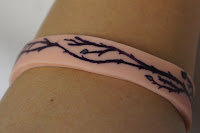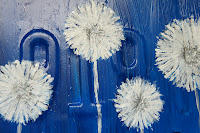
Weaving rubber inner tubes is actually more difficult than it looks. I have started larger rubber weaving projects before, but got too frustrated and gave up on them. For my second project, I gave it another go...on a smaller scale. The strips of inner tube slip and don't like to stay flush with the other strips. I think this is because of the thickness. I went to
SCRAP PDX last week and found a simple loom that I am going to try weaving rubber and hope it works better than taping pieces to my glass board.
 Recycled Material:
Recycled Material: rubber inner tube
Other Material: heavy tape (I like using electrical tape on rubber) thread, bias tape or something for edging, snap
Tools: scissors, needle and thread or sewing machine
How I did it: I cut inner tubes into strips that are 1/2" wide.
Some inner tubes (usually road bike inner tubes) have lines that measure about this width and make cutting a lot less of a headache. I find it easier to cut the length of the tire then cut down the sizes I need. Then I cut 9 of the strips to 10" lengths and 16 strips to 6/5" lengths (this will give you extra room to work and allow about 1/2" edges). The size of the finished product is 3"x4.5". As I said above, I used a glass cutting board, then taped the 9 long strips flush against each other - I only taped along the top and left the bottom loose. Then I took one of the shorter strips and wove it through the longer strips, one over and one under.
Make sure the pieces of rubber are all facing the right direction. Then repeated the process for the remaining 15 strips, alternating which one started on top and vice
versa.
I call this making my "fabric" when working with recycled/discarded materials. Once the "fabric" was done, I used the electrical tape to measure out the exact size of the purse - 4.5" x 8" but I only taped the bottom and two long sides up to 6". For the remaining 2" I rounded the tape starting at the 6" mark and made the highest point 8". The bottom was folded in half 3" up (inside out) and the remaining rounded 2" was left for the closure flap. I also did a simple stitch to hold the weave together on the short and rounded ends removing the electrical tape as I went along then lined the bias tape on the short ends and used a
sewing machine with the tension set to "9" using a leather needle. Once the edges that were going to show were covered, I hand (back) stitched the sides 3" up with the "fabric" inside out on each side using a large needle removing the tape as I stitched
(it is a pain in the you-know-what to stitch rubber by itself on my little machine so it was just easier to do it by hand).
Once the coin purse was put together, I turned it inside out then marked the placement of the snap. Originally I used a magnetic closure for it, but it was overkill and just stretched the rubber, so I removed it and used a regular sew-on snap. I hid my stitches behind the weave. I left it sitting out to take a picture of it and my sweet little 88 year-old grandmother-in-law walked up and asked me if I made it for her. How could I say "no"?
What I would do differently: I would probably do a lining because the rubber still stretches a little bit when you pull on the snap, but not as badly as it did with the magnetic closure. Like I mentioned earlier, I am going to see how the loom I got works out, otherwise I am going to have to figure out an easier solution by fashioning something homemade.
 How I did it: I cut a piece of inner tube 1.25" x 8.25" for the base of the cufflet. I used the square craft punch and punched 5 squares evenly spaced on the rubber, leaving about an inch of rubber on both ends to set the snaps. I cut the ribbon 9.25" long and folded each end under .5" and lined it up with the rubber to make sure it was seen through the squares. I punched the holes for the snap placement through the ribbon and rubber and set the snaps. I cut the electrical tape into this strips and used the strips to hold the ribbon in place lengthwise.
How I did it: I cut a piece of inner tube 1.25" x 8.25" for the base of the cufflet. I used the square craft punch and punched 5 squares evenly spaced on the rubber, leaving about an inch of rubber on both ends to set the snaps. I cut the ribbon 9.25" long and folded each end under .5" and lined it up with the rubber to make sure it was seen through the squares. I punched the holes for the snap placement through the ribbon and rubber and set the snaps. I cut the electrical tape into this strips and used the strips to hold the ribbon in place lengthwise.
















































